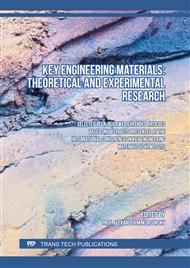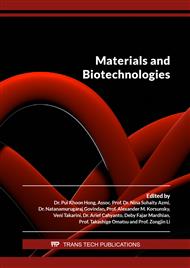[1]
M. Guo, J. Nowakowska-Grunt, V. Gorbanyov and M. Egorova, Green Technology and Sustainable Development: Assessment and Green Growth Frameworks, Sustainability. 12 (2020) 6571.
DOI: 10.3390/su12166571
Google Scholar
[2]
S. Shan, S.Y. Genç, H.W. Kamran, and G. Dincad, Role of green technology innovation and renewable energy in carbon neutrality: A sustainable investigation from Turkey, J. Environ. Manage. 294 (2021) 113004.
DOI: 10.1016/j.jenvman.2021.113004
Google Scholar
[3]
M. Wang, Y. Li and G Liao, Research on the Impact of Green Technology Innovation on Energy Total Factor Productivity, Based on Provincial Data of China, Front. Environ. Sci. 9 (2021) 710931.
DOI: 10.3389/fenvs.2021.710931
Google Scholar
[4]
UN General Assembly, Transforming our world : the 2030 Agenda for Sustainable Development. (2015).
Google Scholar
[5]
KPMG, Global Automotive Executive Survey. (2017).
Google Scholar
[6]
M. Ni, An Overview of Hydrogen Storage Technologies, Energy Explor. Exploit. 24 (2006) 197-209.
Google Scholar
[7]
E. Rivard, M. Trudeau and Karim Zaghib, Hydrogen Storage for Mobility: A Review, Materials. 12 (2019) (1973).
DOI: 10.3390/ma12121973
Google Scholar
[8]
F. Ustolin, N. Paltrinieri and F. Berto, Loss of integrity of hydrogen technologies: A critical review, Int. J. Hydrog. Energy. 45 (2020) 23809-23840.
DOI: 10.1016/j.ijhydene.2020.06.021
Google Scholar
[9]
V. Tietze, S. Luhr and D. Stolten. Bulk Storage Vessels for Compressed and Liquid Hydrogen, in: D. Stolten, B. Emonts (Eds.), Hydrogen Science and Engineering : Materials, Processes, Systems and Technology, Wiley‐VCH Verlag GmbH & Co. KGaA, Weinheim, Germany, 2016, pp.659-690.
DOI: 10.1002/9783527674268.ch27
Google Scholar
[10]
Y. Liu, L. Ren, Y. He and HP Cheng, Titanium-decorated graphene for high-capacity hydrogen storage studied by density functional simulations, J. Phys.: Condens. Matter. 22 (2010) 445301.
DOI: 10.1088/0953-8984/22/44/445301
Google Scholar
[11]
V. Mahamiya, A. Shukla and B. Chakraborty, Scandium decorated C24 fullerene as high capacity reversible hydrogen storage material: Insights from density functional theory simulations, Appl. Surf. Sci. 573 (2022) 151389.
DOI: 10.1016/j.apsusc.2021.151389
Google Scholar
[12]
L. Yuan, L. Kang. Y. Chen, D. Wang, J. Gong, C. Wang, M. Zhang, and X. Wu, Hydrogen storage capacity on Ti-decorated porous graphene: First-principles investigation, Appl. Surf. Sci. 434 (2018) 843-849.
DOI: 10.1016/j.apsusc.2017.10.231
Google Scholar
[13]
A. Züttel, Materials for hydrogen storage, Materials Today. 6 (2003) 24-33.
Google Scholar
[14]
D.S. Bayasen, A.R. Villagracia, G.R. Pedrosa, H. Lin, H.L. Ong, M. David and N. Arboleda Jr., Hydrogen adsorption on calcium-decorated planar aluminene using density functional theory, IOP Conf. Ser. Earth Environ. Sci. 463 (2020) 01210.
DOI: 10.1088/1755-1315/463/1/012104
Google Scholar
[15]
G.R. Pedrosa, A.R. Villagracia, D.S. Bayasen, H. Lin, H. L. Ong, M. David and N. Arboleda Jr., First principles investigation on the nitrogen-doped planar aluminene for hydrogen storage application, IOP Conf. Ser. Earth Environ. Sci. 463 (2020) 012103.
DOI: 10.1088/1755-1315/463/1/012103
Google Scholar
[16]
G. Kresse and J. Furthmülle, Efficient iterative schemes for ab initio total-energy calculations using a plane-wave basis set, Phys. Rev. B: Condens. Matter. 54 (1996) 11169.
DOI: 10.1103/physrevb.54.11169
Google Scholar
[17]
A. R. Villagracia and H. L. Ong, Spin-polarized Density Functional Theory on Iron-decorated Planar Aluminene Systems for Hydrogen Storage, IOP Conf. Ser. Earth Environ. Sci. 765 (2021) 012056.
DOI: 10.1088/1755-1315/765/1/012056
Google Scholar
[18]
J. I. Enriquez and A. R. Villagracia, Hydrogen adsorption on pristine, defected, and 3d-block transition metal-doped penta-graphene, Int. J. Hydrog. Energy. 41 (2016) 12157-12166.
DOI: 10.1016/j.ijhydene.2016.06.035
Google Scholar
[19]
A.R. Villagracia, H.L. Ong, D.S. Bayasen, H. Lin, M. David, and N. Arboleda Jr., Hydrogen adsorption on calcium, potassium, and magnesium-decorations aluminene using density functional theory, Int. J. Hydrog. Energy. 46 (2021) 16676-16684.
DOI: 10.1016/j.ijhydene.2020.11.087
Google Scholar
[20]
A.R. Villagracia, H.L. Ong, M. David, and N. Arboleda Jr., First Principles Investigation on H2 Adsorption on the Pristine 2-Dimensional Hexagonal Aluminum , IOP Conf. Series: Earth and Environmental Science 268 (2019) 012135.
DOI: 10.1088/1755-1315/268/1/012135
Google Scholar



